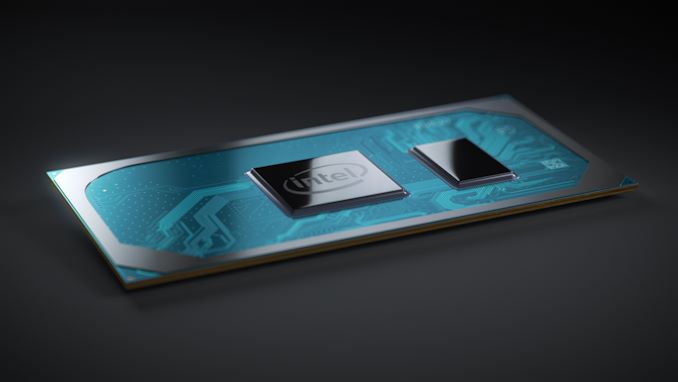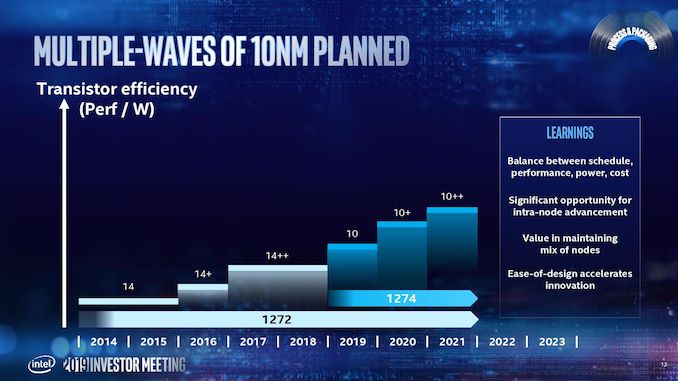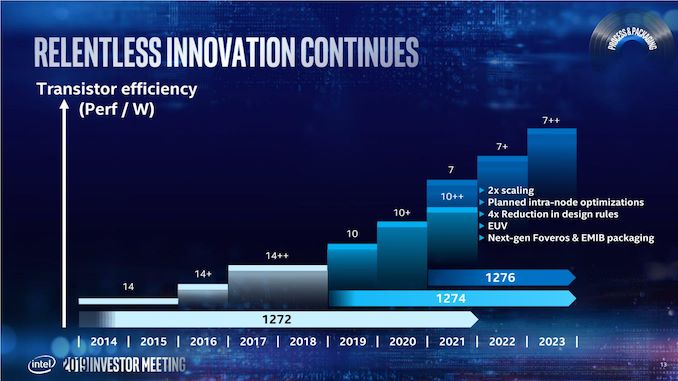Intel Q3 2019 Fab Update: 10nm Product Era Has Begun, 7nm On Track
by Anton Shilov on October 28, 2019 9:30 AM EST
After years of delays, Intel is finally shipping its 10 nm processors in high volume, and the company is preparing to fire up another fab to produce an even larger volume of 10nm products. Along with producing more of the company's existing Ice Lake-U/Y products, Intel is also planning for server CPUs and GPUs as well, with Ice Lake-SP CPU as well as the DG1 GPU already up and running in Intel’s labs. Meanwhile, even farther out, Intel is eyeing 2021 for the rollout of its EUV-based 7nm process.
During its earnings call on Thursday, Intel said that so far 18 premium systems based on its 10th Generation Core (Ice Lake) processors have been formally introduced and 12 more are expected in 2019. Right now, the company produces all of its 10 nm CPUs in Hillsboro, Oregon and Kiryat Gat, Israel. Starting next quarter, the company expects 10 nm chips to also ship from its Chandler, Arizona, fab, which will increase supply of Ice Lake processors and will get Intel prepared for a broader use of the manufacturing process that had caused company a lot of troubles.
In addition to client Ice Lake CPUs and Agilex FPGAs that are currently shipping, Intel’s 10 nm portfolio includes datacenter-grade Xeon (Ice Lake-SP) processors due in the second half of 2020, discrete DG1 GPU(s), an AI inference accelerator, and a 5G base station SoC. One thing to keep in mind here is that Intel will use different iterations of its 10 nm technology to make different chips.
Here is what Bob Swan, CEO of Intel, said:
“The Intel 10 nm product era has begun and our new 10th Gen Core Ice Lake processors are leading the way. In Q3, we also shipped our first 10 nm Agilex FPGAs. In 2020, we will continue to expand our 10 nm portfolio with exciting new products including an AI inference accelerator, 5G base station SoC, Xeon CPUs for server storage and network, and a discrete GPU. This quarter we have achieved power on exit for our first discrete GPU DG1, an important milestone.”
The big news here is that Intel produced the first samples of its DG1 GPU back in Q3, which means that the company now has actual silicon to work with. The chip will undergo at least one more iteration before it will be ready to ship commercially, but it is a good sign that Intel’s A0 DG1 GPU could be turned on. If Intel wants to launch these GPUs in mid-2020, then this is the right window to begin working on actual silicon.
One of the key operational challenges that Intel faces today in regards of its 10 nm fabrication process are yields, as they thwarted the technology from going HVM (high volume manufacturing) for years. According to Intel, yields are improving ahead of expectations for both for client and datacenter CPUs, though the company did not disclose any numbers.
7nm Technology on Track, 5nm in Development
Meanwhile, with their 10 nm evolution roadmap set till 2021, Intel’s manufacturing technology teams are now focused on 7 nm and 5 nm processes. Along with their 10nm status update, in their earnings call Intel has re-iterated that its EUV-based 7 nm technology was on-track for HVM in 2021, and that development of its 5 nm node was proceeding as planned.
According to Intel, having learnt from its 10 nm fabrication process and how its problems harmed its roadmap, the company has radically changed its approach to development of manufacturing technologies and actual products. The company no longer sets ultra-ambitious goals for scaling each node, but attempts to find a right balance between performance, power, cost, and timing. Furthermore, the manufacturer no longer designs products for a particular process, but intends to use the most optimal one it has at the moment. Overall, Intel says that it intends to get back to its usual process technology cadence and introduce brand-new technologies every 2 to 2.5 years, and recapture its process leadership in the future.
Intel’s first product to be made using its 7 nm manufacturing technology is its ‘big’ GPU for high performance computing that is due in Q4 2021, two years after the launch of the 10 nm Ice Lake CPU. Intel says that its 7 nm process is well on-track and the product will be released as planned. While Intel also plans to use 7+ and 7++ technologies in 2022 and 2023, the company is already working on its 5 nm process and is currently ‘engineering’ it, which means that the path-finding stage has been passed and fundamental things like materials and transistor structures were set.
Here is what Bob Swan, CEO of Intel, told analysts and investors on Thursday:
“We are on track to launch our first 7 nm based product, a datacenter-focused discrete GPU, in 2021, two years after the launch of 10 nm [products]. We are also well down the engineering path on 5 nm.”
Related Reading:
- Intel Begins Commercial Shipments of 10nm Ice Lake CPUs to OEMs
- The Ice Lake Benchmark Preview: Inside Intel's 10nm
- Examining Intel's Ice Lake Processors: Taking a Bite of the Sunny Cove Microarchitecture
- Intel Details Manufacturing through 2023: 7nm, 7+, 7++, with Next Gen Packaging
- Intel Process Technology Update: 10nm Server Products in 1H 2020, Accelerated 7nm in 2021
Source: Intel












59 Comments
View All Comments
Marlin1975 - Monday, October 28, 2019 - link
" Intel is finally shipping its 10 nm processors in high volume"Define high volume. Seems 10nm has started with a wimper at best. And even Intel says it will not be till later 2020 till more major 10nm cpus come out. Thats assuming all goes to plan and no issues come up.
shabby - Monday, October 28, 2019 - link
And define which processors, those party 15w ones? PfftSantoval - Monday, October 28, 2019 - link
No word yet on desktop full power -S or even mid power -H parts fabbed at 10nm. Which almost certainly means there won't be, and Intel will release Comet Lake-S/H instead, at 14nm++++. The question is if they'll repeat the same late next year when they release Tiger Lake. Word on the street is that the successor of Comet Lake-S/H is Rocket Lake-S/H, also fabbed at 14nm+++++ but apparently with a new μarch (either Sunny or Willow Cover cores and either Gen11 or Gen12 iGPUs).eek2121 - Monday, October 28, 2019 - link
Those 15 watt CPUs have a use. Not everyone wants (or needs) a super thick battery draining high end laptop. That being said, I'll stick with my Threadripper on the desktop and skylake on my laptop for the time being.drothgery - Monday, October 28, 2019 - link
You mean the highest-volume CPU category for Intel?evilpaul666 - Tuesday, October 29, 2019 - link
I don't follow them super closely, but the new 15W parts didn't seem particularly impressive compared to the previous Coffee Lake ones.goatfajitas - Monday, October 28, 2019 - link
"seems 10nm has started with a wimper at best"Exactly - as it is with 10nm plus the re-re-re-re-retooled 14nm they still cant keep up with production. That is mostly due to AMD's competition and Intel having to use more cores per CPU than expected... Anyhow "volume" is being used very loosely here.
peevee - Monday, October 28, 2019 - link
A little survey. Who would be interested in Intel's 10nm DG1 GPUs, given that Navi is 7nm, by the next year we will have a next gen, and Intel is going to release an all-new architecture with all-new drivers and all-new bugs? What if it's not even PCIe4?eek2121 - Monday, October 28, 2019 - link
I suspect that Intel's GPUs are going to outperform current Navi. Big Navi may be a different story though. If you are a good consumer, you won't be loyal to any brand, and instead buy based on price/performance/overall value. If Intel launches a competitive GPU to current NVIDIA/AMD offerings, then I expect many consumers will consider them. If price is the least bit out of whack, or performance isn't up to par compared to the competition, they are going to have a hard time. a 3 horse race is a hell of a lot harder to deal with to begin with, and when you are years behind the competition it becomes more of an issue.peevee - Monday, October 28, 2019 - link
Do you really believe they are going to be a good value with brand new(=buggy) drivers and worse technology? Well, probably Intel will give them out below cost to volume manufacturers...